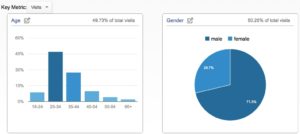Choosing the Right Social Media Platform for Your Business
Which social media platforms you choose will have a huge effect on what marketing results you’ll end up generating in the end. The reason to that is because all social media platforms have different demographics and nature.
For example, if you’re a visual driven brand, some platforms might be a better fit for you, while if you’re a business who aren’t a visual driven brand, other platforms might be able to generate better results for you.
Of course, your brand can not dominate them all, unless you have an unlimited amount of resources.
Yet still, if that would be the case, focusing on some “main platforms” where you put most of your energy would still be more beneficial for you.
That’s why choosing platforms to put your effort into is extremely important.
In this article, we’ll, therefore, give you insights on how the most common social media platforms work, what demographics they have, and what kind of businesses they are best suited for; so you can decide with confidence which you should focus on.
So, how do you actually choose?
First of all, there’s something that you must be absolutely surefire about. That is who your audience are.
When you know who you are targeting, you make it a lot easier to find the ultimate social media platforms, because once you have defined your target audience, you can instantly remove some platforms from the equation.
If you’ve created a strong marketing strategy, you’ve probably defined your audience already, but if not – here are some questions to ask yourself to get a better understanding of your audience:
- What is the age of your audience?
- Where are they located?
- Does your audience consist of mostly men or women?
- What are their interests?
- What is their income?
- Where do they spend their time?
The last question is a bit tricky to respond to if you’ve never done any research, but don’t worry, you’ll soon be able to identify where they are spending their time.
1. Set up goals
Your goals will also determine what platforms that are relevant to your brand. If you’re looking to use social media only to build brand awareness, some platforms might be better for you to do so on. If you, on the other hand, want to drive direct sales, you might want to look at different platforms.
Social media is a powerful tool that can be used for a variety of different purposes.
Some brands might only be using social media for customer service and PR, and other brands might only focus on spreading information about the latest news regarding the brand.
Heck, some brands main objective with social media might be to connect with their audience on a more personal on a more equivalent level.
As you can see, brands have many different purposes with social media, and it’s important that you know yours.
More on that later.
2. Identify audience and platforms
Here comes the tough part.
As we talked about earlier, the demographics of the social media platform is the most important part when choosing platform. However, things such as the nature of the platform are also extremely important.
You’ll also want to understand where your audience spends most of their time if they are using several platforms.
Let’s get started.
Choosing the Right Social Media Platform for Your Business:
Instagram have been considered to be “the app for teenagers” and is sometimes completely ignored by brands because they don’t believe an older generation is to be found there.
While that might have been the case a few years ago, Instagram’s user base is quickly increasing in age – becoming something universal, that is actively used by people from all ages.
Instagram is a visually based platform, focusing on images and videos which mean that it is more suitable for brands who can share interesting visuals and less suitable for brands who are more focused on services etc.
An interesting point to make here for brands who are targeting an older audience is the following:
Because Instagram mostly has been a platform for the younger generation, brands who are targeting an older demographic hasn’t bothered Instagram. However, now and in the near future, Instagram will be a completely different ball game. And that’s an advantage for you!
If you are a brand with a slightly older target audience who decide to hop on Instagram, there’s a big chance that you’ll find plenty of success because the competition of the older generation’s attention isn’t that big, while the use of Instagram for this audience is increasing dramatically.
Instagram reached 700 million users in April 2017 and is currently one of the fastest growing social media platforms.
Let’s take a look at the demographics of Instagram:
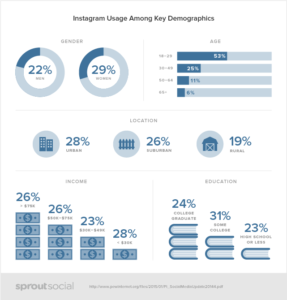
.. And a quick summary of Facebook statistics:
- 300 million monthly active users
- 75 million daily users
- 20% of Internet users are on Instagram
- 27% of the US population uses Instagram
- 47% of Instagram users access the app on their phone and 53% on their tablet
(Source: SproutSocial)
Facebook is one of the most powerful social media platforms in the world.
It is also the largest.
Facebook boasts 1.94 billion monthly active users as of March 2017, which means you have the potential of reaching a lot of people. And you can assume that most people are on it. Even if they’re more active on other platforms, they can still be found there – with the right methods.
Facebook is a platform that is based both on visual content and written content, which is great for universalness – allow brands to use whichever they are best at.
Facebook is one of those platforms almost any business can benefit from, however, because the number of users is so high, it also means the competition is higher.
That’s why, when using Facebook, you need a strategy that sets you apart from your competitors. Also, thanks to Facebook’s algorithm that limits your organic reach, having a large budget is to recommend if you want to have some kind of reach. If you don’t, there are other platforms that generate a much higher organic reach.
Facebook has time and time over shown that the best way to get good marketing results there is to show the people being the brand, give insights into your everyday business lives and portray you and your co-workers in a friendly way. This helps build up valuable, genuine relationships with your audience which ultimately leads to more followers and a bigger trust in your brand.If done correctly, your fans become loyal followers and Facebook can be a very significant lead generator.
If you don’t feel comfortable displaying your company in that manner and want to show a more “serious” business side when marketing your brand. Facebook might not be the perfect fit for you.
Let’s take a look at the demographics of Facebook:
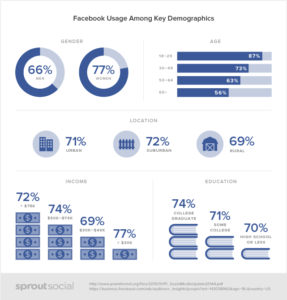
.. And a quick summary of Facebook statistics:
- 1.4 billion monthly active users
- 655 million monthly active users that are mobile only
- 65% of Facebook videos occur on mobile devices
- 40 million small businesses have Facebook Pages
(Source SproutSocial)
Let’s jump to Twitter.
Twitter is a platform that is all about sharing content here and now. By allowing Tweets to be a maximum of 140 characters, the platform has become a place where you share your thoughts on the go. Brands often use Twitter to share live updates of events and other kinds of happenings to rapidly give their followers the latest info.
Twitter is not like Facebook or Instagram where you polish your content to perfection – even if you can link to more polished content on the platform, Twitter is more a tool for quick answers and quick responses.
If you are a brand who like to converse with your audience frequently and often, Twitter is for you.
It is also one of the best tools for customer service because the simplicity of giving quick responses is something that is appreciated by many businesses.
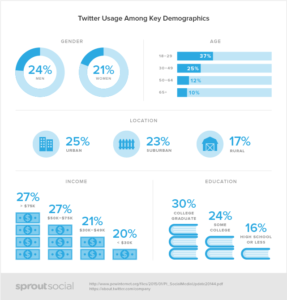
Pinterest is a platform that is all about visual content.
The platform allows you to pin or post photos and videos onto boards. Among all platforms, Pinterest is the most visually driven.
Something that is also interesting when it comes to the demographics of Pinterest is that most of their users are female, even if their male user base has increased slightly over the years.
Pinterest is a platform that is mostly used by brands that are targeting women, and if you’re a brand that is targeting women, this platform might be for you.
In order to succeed on Pinterest, you need to share strong graphics to engage users. However, if you succeed with this, you can increase your sales dramatically. According to Pinterest, 93 percent of Pinners (male and female) shopped online in the past six months.

Linkedin is known to be the platform for older audiences.
LinkedIn is a bit different from most other platforms because its main purpose is not entertainment, instead, it is job searching and professional networking that is the main purpose of the platform.
Therefore, the platform is best suited for B2B, relationship building, and employee recruitment.
You can also join groups and discussions where you can discuss various subjects and show your personal and business expertise, and possibly attract various business people.
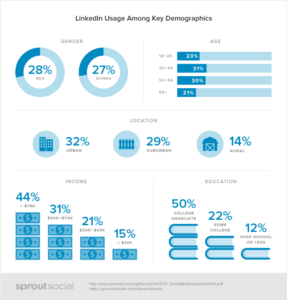
YouTube
YouTube is a great platform to show your businesses expertise, however, to do that, you must know how to create interesting and appealing videos.
YouTube currently holds 1 billion users, and part of that is because you don’t need to sign up to use it. Anyone can watch videos on YouTube, and best of all – you can find answers to almost anything on there. Just like a video version of Google.
YouTube is, therefore, the most attractive platform to visit for people who wants to know “how to” in video format.
On the platform, you can watch “how to” videos regarding almost anything and learn how to do it.
If you can provide value with your videos on YouTube, you can gain tons of traction, however, it demands hard work and creativity.
The great thing about this platform is that you can showcase your product in an interesting and new way.
However. Being unique is critical as there are over 1 billion videos on the platform. If people don’t find your video interesting, they can always watch another video.
Let’s take a look at the demographics of YouTube:
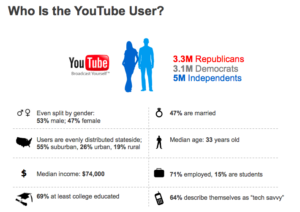
Google+
Google+ is more known to hold an older user base with interests such as software, design and web development.
The main reason that a lot of businesses are using this platform is however not to reach their target audience in the sense that they reach it directly on the platform.
Instead, the main focus for a lot of brands is the indirect marketing it generates, in this case, called Search engine optimization.
Because Google+ is owned and run by Google search engine, it holds a lot of value when it comes to driving traffic to your website.
If your goal is to get you website to rank better in Google and ultimately get more visitors, Google+ might be for you.
Let’s take a look at the demographics of Google+:
